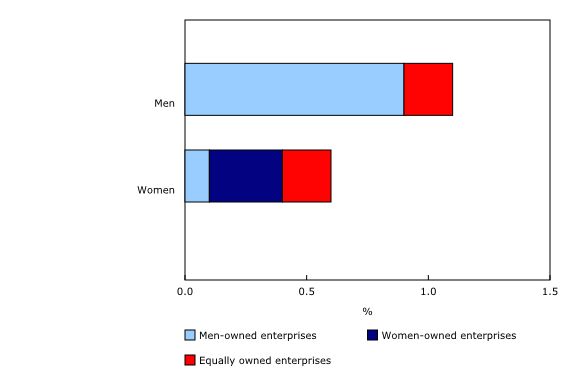Study: Who are the Men and Women Entering Business Ownership in Canada?
Archived Content
Information identified as archived is provided for reference, research or recordkeeping purposes. It is not subject to the Government of Canada Web Standards and has not been altered or updated since it was archived. Please "contact us" to request a format other than those available.
Released: 2021-03-08
Prior to the COVID-19 pandemic, although women were about half as likely as men to become owners of a private incorporated business, women and men were influenced by similar factors with regard to entry into private incorporated business ownership. However, statistically significant sex differences existed in the impact of these factors on the probability of entry.
These are some of the key findings of a new study titled "Who are the Men and Women Entering Business Ownership in Canada?" published today by Statistics Canada. Using the Canadian Employer–Employee Dynamics Database, the study offers a detailed socioeconomic profile of entrants into private incorporated business ownership in 2016, the latest data available. The analysis examines key sex differences in human capital, financial capital, social capital and sociodemographic factors, and the sex differences in the impact of these factors on the decision to enter into business ownership. It also investigates how these factors influence entry into men-owned enterprises (MOEs), women-owned enterprises (WOEs) and equally owned enterprises (EOEs).
In 2016, men were almost twice as likely to enter into business ownership compared with women; 1.1% of men became business owners, compared with 0.6% of women. Male entrants were concentrated in MOEs, while the distribution of female entrants was more balanced across the three types of enterprises. Overall, 79.0% of male entrants into business ownership became owners of MOEs, compared with 44.2% of women entrants who became owners of WOEs.
Although the factors that influenced the decision of men and women to enter into business ownership were almost the same, there are significant sex differences in the magnitude of impacts for these factors. For both sexes, having a spouse who was already a business owner in the previous year was an important determinant of entry into business ownership. However, the probability of entry for a woman whose spouse was a business owner was 2.3 percentage points lower than that for a man, even though female entrants were proportionately more likely to have a spouse who was a business owner.
Similarly both men and women who were primarily in unincorporated self-employment in the year prior to entry were more likely than paid employees to become incorporated business owners. However, self-employed men were 1.6 percentage points more likely than their female counterparts to become business owners. This is despite the fact that, among both men and women, about one-third of entrants were self-employed in the previous year.
Furthermore, it was also found that negative income and being unemployed led to a greater probability of entry into business ownership. The impact was higher for men than women. This is despite the fact that women were more likely to be unemployed in the year prior to entry (9.0% versus 4.2%), and, in the five-year period before entry, women were more likely to have faced a negative income shock (7.6% versus 0.5%).
Other important results include the fact that having young children tended to attract men to MOEs and EOEs and women to WOEs and EOEs. However, having a disability or living in a rural area was found to discourage individuals from entering business ownership. Family income and experience in the goods-producing sector tended to pull women towards MOEs, while having a spouse tended to attract both sexes to EOEs.
The findings from the regression-based analysis are relevant in the context of the recovery from the COVID-19 pandemic. The COVID-19 crisis has generated shocks that echo the factors analyzed in the study. For example, individuals who were unemployed were more likely than paid employees to enter business ownership. Similarly, individuals tended to be pushed toward business ownership by having suffered a major negative income shock; being a caregiver; being a recent immigrant; and being widowed, divorced or separated. Interestingly, these factors tended to attract men to MOEs and women to WOEs and EOEs.
Note to readers
A women-owned enterprise is defined as a private incorporated business where the shares owned by women are greater than or equal to 51%. A men-owned enterprise is a private incorporated business where the shares owned by men are greater than or equal to 51%. An enterprise is considered equally owned if women and men own 50% of the shares.
Products
The study "Who are the Men and Women Entering Business Ownership in Canada?," part of the Analytical Studies Branch Research Paper Series (11F0019M), is now available.
Contact information
For more information contact us (toll-free 1-800-263-1136; 514-283-8300; STATCAN.infostats-infostats.STATCAN@canada.ca).
To enquire about the concepts, methods or data quality of this release, contact Douwere Grekou (douwere.grekou@canada.ca).
- Date modified:


